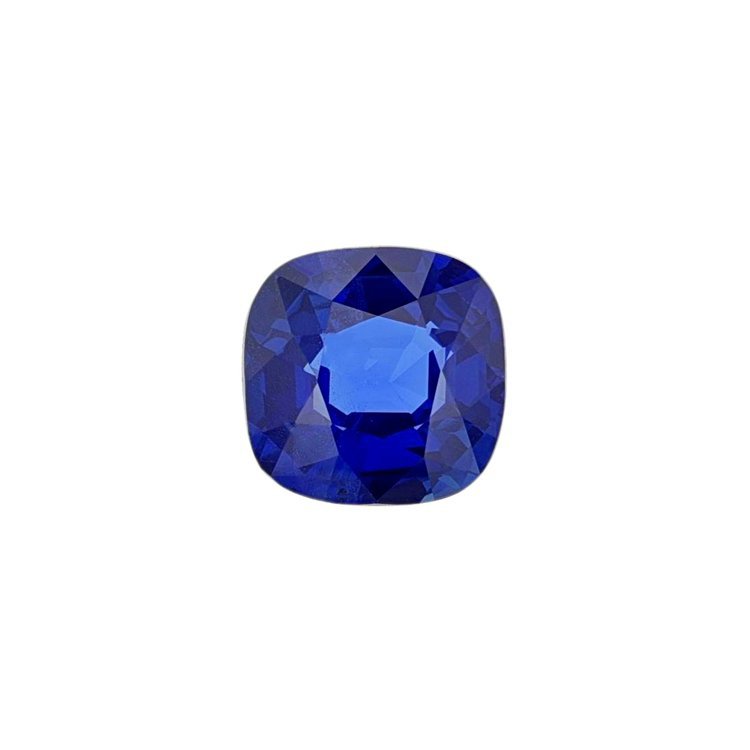HEAT VS. NO HEAT SAPPHIRES
Article by Sumeet Chordia, G.G.
The Big Debate: Heat vs. No Heat Sapphires
December 21, 2020
If you are shopping for sapphires, you will come across stones that are either natural (no-heat, unheated) or enhanced by heat (heated). There are other methods of treatment performed on sapphires, however, this article only compares unheated sapphires with heated sapphires because it is the most prevalent method of treatment in the market today.
A 1-ct. natural no-heat cushion-shaped blue sapphire. Photo by RAF Jewels ©
The application of heat treatment on sapphires dates back many centuries and is widely accepted in the global market. The treatment is effective, stable, and allows for an affordable alternative to their counterpart — the unheated natural sapphires. Although heated sapphires are available at every brick-and-mortar or online retailer around the world, natural unheated sapphires are highly coveted for their visual appeal, history, use in iconic and uber-fine jewelry, rarity, and value.
GEMOLOGY 101: SAPPHIRE
Sapphires are a variety of the mineral Corundum, which is chemically Aluminum Oxide. Other members of the corundum family include ruby, padparadscha (orangy-pink), pink sapphire, yellow sapphire, star sapphire, and many other hues of sapphires. But regardless of their color, the foundational composition for all these gemstones is the same.
So, what gives sapphires their blue color? Trace Elements. The blue color in sapphires is attributed to the type and amount of Titanium and Iron present in the crystal. The right balance of Titanium, Iron, with Aluminum Oxide will result in a beautiful blue color sapphire.
Why do some sapphires exhibit low saturation of color? Stones that do not have the sufficient amount, type and combination of trace elements will not have a strong saturation of blue. These sapphire are ideal candidates to undergo heat treatment for color improvement.
GENUINE HEATED SAPPHIRES
A ten-carat heated sapphire three-stone engagement ring. Photo by RAF Jewels ©
Why heat sapphires? To improve the color, offer various size, get a higher return on investment, and offer customers an affordable choice. An individual or company in the early stages of the supply chain felt that their unearthed, pre-heated stone lacked a desirable color. They can choose to leave the stone as-is or mark it for heat treatment. If they were to leave the stone in its natural state they would not reap a financial gain. But if they improve the color via heat treatment, the stone becomes more sellable and they can get a better return on their investment. For the consumer, these stones are a great, lower-cost, alternative to natural, un-heated sapphires.
After heating a sapphire, is the color permanent? Yes, this is a boon for heated sapphires. The color of a heat-treated sapphire will remain permanent and will not change or fade, unless the stone undergoes a secondary treatment. This is the reason why heat treatment on sapphires is accepted by most retailers. Some jewelry houses still prefer to offer only natural, unheated sapphires, but they would happily use a heated sapphire if it was requested by their client.
Are all heated sapphires the same? No, and this is important. Heating only improves the color of a gemstone but it is not an equalizer. The improved color will vary among stones and all other quality attributes remain unique to each stone. Additionally, some stones go multiple enhancements to improve their appearance and hide bothersome defects.
Are heated sapphires undesirable? No, the important factors for a desirable gemstone are: a beautiful color, eye-clean clarity, well-cut, and pleasant crystal. However, heated sapphires do lack the natural and rarity appeal of unheated sapphires.
NATURAL, (NO-HEAT) UNHEATED SAPPHIRES
A natural sapphire being prepared for examination under microscope. Photo by RAF Jewels ©
By appearance, is there a difference between natural and heat-treated sapphires? Yes, but to a trained eye. Generally speaking, natural no-heat sapphires will have a softer luster and smoother surface appeal. Heated sapphires exhibit a glass-like surface which feels hard and unnatural.
Are natural, no-heat sapphires more rare and valuable? Yes, sapphires that have not undergone any color or clarity enhancement along the supply chain (mine to retail) are rare and therefore more valuable than heated sapphires that are abundant in the market.
Are all unheated sapphires the same? No. Just like individuals, each unheated sapphire is unique and the sum of its attributes: color, clarity, cut, crystal, carat weight, and geographic origin.
Why do unheated, gem-quality sapphires command high prices? Fine or gem-quality blue sapphires are rare and sought-after by collectors. For a sapphire to be considered gem-quality it must exhibit:
A beautiful combination of hue, tone, and saturation of blue (Color)
Insignificant to no eye-visible inclusions (Clarity)
A high degree of brilliance to reflect the color (Cut)
A high degree of luster for the movement of light in the stone (Crystal)
A moderate to significant size (Carat Weight)
No man-made treatments to enhance/improve the stone’s color or clarity (Enhancements)
In short, there must be a strong balance and combination of nature's ingredients and a cutter's artistry.
SIGNIFICANCE OF GEMOLOGICAL CERTIFICATES
How will I know if a sapphire is natural (unheated) or heated? Request a gem lab certificate. This scientific assessment can only be done by a highly experienced gemologist and more convincingly by a reputable laboratory such as GIA, AGL, Gübelin, SSEF, or GRS that have years of research data, high-tech equipment, and experienced gemologists analyzing their findings. Appraisals do not count - they are only to assess the value.
Should I request a certificate? It depends. If you are making a significant investment you should request a certificate from a reputable gemological laboratory, even at an additional cost. In extremely high-end gemstones we recommend multiple certificates.
For gemstones that are small in size, the cost of the certificate may exceed the purchase of the total piece. In such cases, it may not be advisable to spend the money on a certificate.
INVESTMENT
Which is a better investment? Unheated Sapphires. Sapphires of vivid/royal blue color and fine clarity, which have not undergone any treatment, are the ideal investment. They are becoming increasingly more rare and their demand remains high. Additionally, many signed, vintage, and antique pieces by famous houses are set with natural, no-heat sapphires. While these pieces hold value due to their history, provenance, originality, design, period, etc., the appeal of unheated sapphires is highly valuable and attractive.
Fine quality natural sapphires are becoming increasingly rare and have shown a substantial increase in market value over time. Fine gem-quality, sapphires that have been treated by heat have also increased in value due to demand, but not as significantly. A fine-quality sapphire, whether natural or heated is a good purchase.
Recommended Readings: Gemstone Origin: Series 1: Introduction or 10 Steps to Buy a Natural Sapphire
#
Updated: February 20, 2024
Originally Published: May 20, 2016



